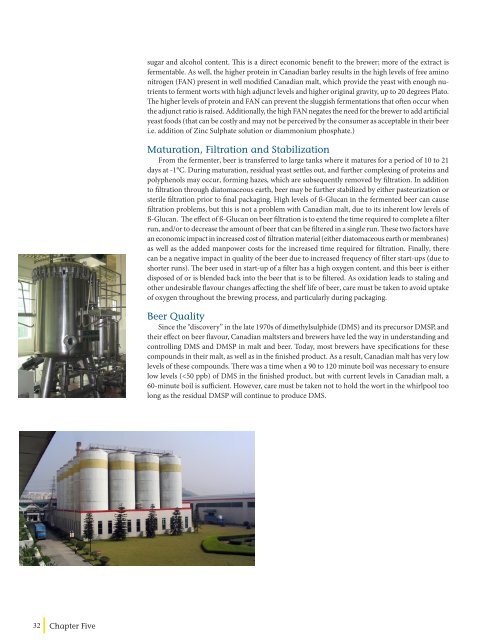MALTING QUALITY TRAITS - Canadian Malting Barley Technical ...
MALTING QUALITY TRAITS - Canadian Malting Barley Technical ...
MALTING QUALITY TRAITS - Canadian Malting Barley Technical ...
Create successful ePaper yourself
Turn your PDF publications into a flip-book with our unique Google optimized e-Paper software.
32<br />
Chapter Five<br />
sugar and alcohol content. This is a direct economic benefit to the brewer; more of the extract is<br />
fermentable. As well, the higher protein in <strong>Canadian</strong> barley results in the high levels of free amino<br />
nitrogen (FAN) present in well modified <strong>Canadian</strong> malt, which provide the yeast with enough nutrients<br />
to ferment worts with high adjunct levels and higher original gravity, up to 20 degrees Plato.<br />
The higher levels of protein and FAN can prevent the sluggish fermentations that often occur when<br />
the adjunct ratio is raised. Additionally, the high FAN negates the need for the brewer to add artificial<br />
yeast foods (that can be costly and may not be perceived by the consumer as acceptable in their beer<br />
i.e. addition of Zinc Sulphate solution or diammonium phosphate.)<br />
Maturation, Filtration and Stabilization<br />
From the fermenter, beer is transferred to large tanks where it matures for a period of 10 to 21<br />
days at -1°C. During maturation, residual yeast settles out, and further complexing of proteins and<br />
polyphenols may occur, forming hazes, which are subsequently removed by filtration. In addition<br />
to filtration through diatomaceous earth, beer may be further stabilized by either pasteurization or<br />
sterile filtration prior to final packaging. High levels of ß-Glucan in the fermented beer can cause<br />
filtration problems, but this is not a problem with <strong>Canadian</strong> malt, due to its inherent low levels of<br />
ß-Glucan. The effect of ß-Glucan on beer filtration is to extend the time required to complete a filter<br />
run, and/or to decrease the amount of beer that can be filtered in a single run. These two factors have<br />
an economic impact in increased cost of filtration material (either diatomaceous earth or membranes)<br />
as well as the added manpower costs for the increased time required for filtration. Finally, there<br />
can be a negative impact in quality of the beer due to increased frequency of filter start-ups (due to<br />
shorter runs). The beer used in start-up of a filter has a high oxygen content, and this beer is either<br />
disposed of or is blended back into the beer that is to be filtered. As oxidation leads to staling and<br />
other undesirable flavour changes affecting the shelf life of beer, care must be taken to avoid uptake<br />
of oxygen throughout the brewing process, and particularly during packaging.<br />
Beer Quality<br />
Since the “discovery” in the late 1970s of dimethylsulphide (DMS) and its precursor DMSP, and<br />
their effect on beer flavour, <strong>Canadian</strong> maltsters and brewers have led the way in understanding and<br />
controlling DMS and DMSP in malt and beer. Today, most brewers have specifications for these<br />
compounds in their malt, as well as in the finished product. As a result, <strong>Canadian</strong> malt has very low<br />
levels of these compounds. There was a time when a 90 to 120 minute boil was necessary to ensure<br />
low levels (


